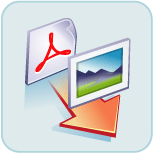Quick Command Line Reference for 'Convert PDF to Image'
Table of File Conversion Constants
|
File Type |
Constant |
|
Independent JPEG Group (*.jpg) |
1 |
|
Windows Bitmap (*.bmp) |
2 |
|
Tagged Image File Format (*.tif) |
3 |
|
Graphics Interchange Format (*.gif) |
4 |
|
EMF (*.emf) |
5 |
|
J2K (*.j2k) |
6 |
|
PCX Bitmap (*.pcx) |
7 |
|
Portable Network Graphics (*.png) |
8 |
|
Sun Rasterfile (*.ras) |
9 |
|
Targa File (*.tga) |
10 |
|
Windows Meta File (*.wmf) |
11 |
ALL COMMAND LINE SWITCHES
| Switch | Meaning |
|
/J{File} |
Specify a 'Conversion Job' file (*.SII) to be done. You must have previously created a 'Conversion Job' file to use this switch. |
|
/S{File} |
Original PDF File(s) to be converted.
A single file including its complete path can be specified for a single file conversion (i.e. "D:\MyImageFiles\AccountsDetail.PDF".
If specifying a single file, make sure that the /T switch also specifies a single output file (i.e. "D:\OutputFiles\TargetOutput.BMP".
Alternatively, you can specify whole directories by using the wildcard syntax (i.e. "D:\MyImageFiles\*.pdf"). If specifying a whole directory, make sure the /T also specifies a whole directory with a new target file extension. (i.e. "D:\OutputFiles\*.TIF").
See also /R for subfolders. |
|
/T{File} |
Target File(s) to be created when converting the Original file(s) to images.
If specifying a single input file, make sure that the /T switch also specifies a single output file (i.e. "D:\OutputFiles\MyOutputFile.TIF".
Alternatively, you can specify whole directories by using the wildcard syntax (i.e. /T"D:\OutputFiles\*.TIF"). If specifying a whole directory, make sure the /S also specifies a whole directory with an original file extension. (i.e. /S"D:\MyImageFiles\*.PDF")
This switch is ignored if the /G Switch is used. |
|
/C # |
tells 'Convert PDF To Image' what the target file type is. You must supply a number for the # symbol. For all constants see File Type Constants. The target file, specified by the /T{Target File(s)} switch, has an extension which determines it's file type. /C is only required if you are not using file names with standard file extensions (standard file extensions are jpg, tif, gif, etc). For example if you working with bitmap files with file names like mybitmap.abc then you definitely need to specify the /C switch. |
|
/G |
Save files to their original folders.
Use this instead of /T to place the converted files in the
same folder as the original file. Cannot be used when
converting a single, specified file from within a folder.
Use the /T switch instead. Files will be saved with the same name as the original but in a .PDF format. You cannot specify a different name for the output file when using the /G switch. |
|
/V |
Verbose mode. Specify this switch to display a message box indicating how the conversion went. See also /L |
|
/R |
Seek out and do all files found in the sub-folders specified in the /S switch. Recursive subdirectories. You may add this switch if you are processing whole directories of files. See /S, /T and /G for more details on selecting whole directories to be converted. |
|
/L{File} |
Log file path and name (i.e. D:\MyLogs\ConvertPDFtoImage.LOG) If this switch is specified a log file with the given path and name will be created and the results of the conversion will be written to it. See also /V. |
|
/B{File} |
Save the Log file as a 'Conversion Job' ONLY IF ERRORS OCCURRED. This is useful if the files that had problems, can be done at a later time, or with a different method. /B differs from /L, since the file generated with /B will not include extraneous comments not allowed in a 'Conversion Job' file. Save as a .SII file type so it can be loaded as a job. |
|
/1{Pages To Convert} |
PDF pages to convert. For example if you have a multipage PDF and you want to convert pages 2-5 use /1 2-5 . ALWAYS put a space after the 1 in /1. To do page one for example use /1 1 |
|
/3{TRUE/FALSE} |
Append to existing when converting to a TIFF. Use /3 TRUE to append /3 FALSE not to. |
|
/4{JPEG Quality}
|
JPEG: Quality of the resulting JPG from 0 to 100 (default is 100). 0 is lowest and 100 is highest quality. The higher the quality the larger the resulting target file. Use /4 100 for highest quality. Default is 100. |
|
/5{Resolution} |
Specified in DPI, the image resolution is critical. Default is 150. |
|
/6{Width} |
Width of the output image in pixels. Leave out this switch or use a value of 0 to use the size within the PDF file. |
|
/7{Height} |
Height of the output image in pixels. Leave out this switch or use a value of 0 to use the size within the PDF file. |
|
/8{TiffConvertToSingleFile } |
TiffConvertToSingleFile: If you are converting multiple pages in a PDF file to a TIFF, you can have a single file output or multiple file output. Use /8 1 to create a single file or /8 0 to create multiple output files. |



